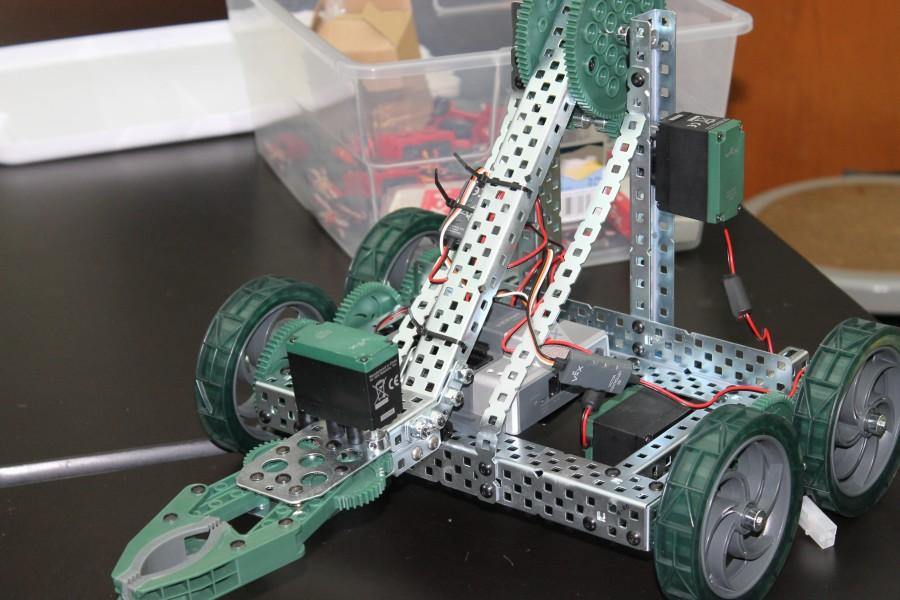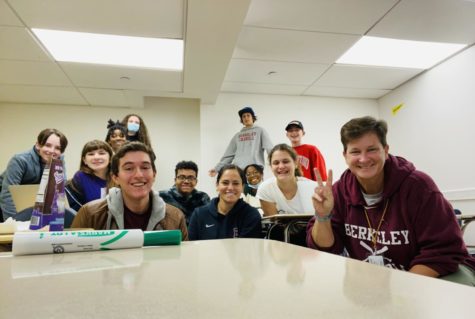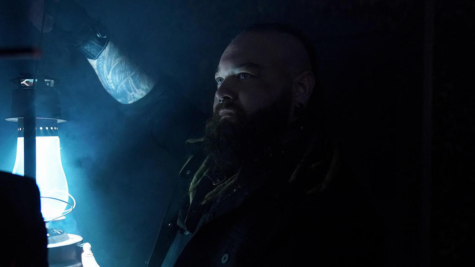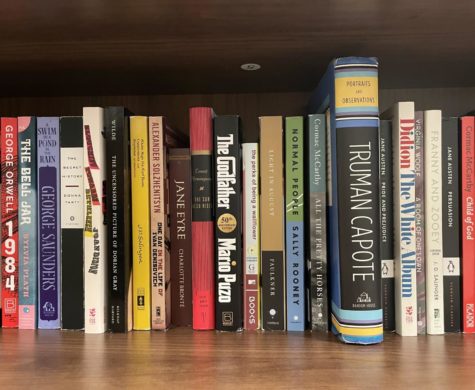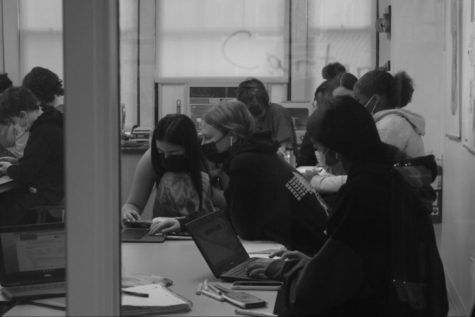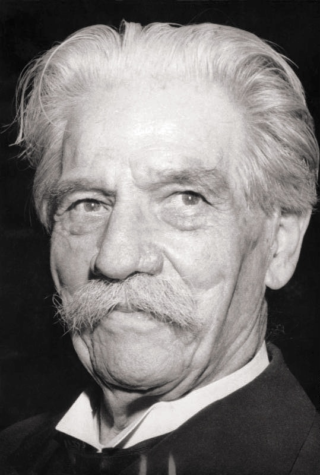From One Spring Intensive to Another
The Journalism 101 spring intensive honed their reporting skills with some very local news. The assignment? Cover 3 of their fellow intensives: Introduction to Robotics, Designing a Musical: Godspell, and Neuropsychology: My Brain/Myself. Read below for a taste of what Berkeley Carroll students were up to before spring break.
Run, Robot, Run!: Introduction to Robotics Spring Intensive
By Sara Tobias
Ceesh, Tango, Kelp, and Groady. Who are they? No, they’re not people, they’re robots. Small, metal, four-wheeled robots with green claws extending from their fronts.
These metal creatures can be found in the Introduction to Robotics Spring Intensive, taught by US Math teacher Alister Kwok and US Science teacher Russell Smith. In this course, students learn how to use the programming language “ROBOTC” to make their handbuilt robots move around and grasp objects.
Each day, students are given a new challenge for their robots. The first two challenges have been to move their robots for a fixed distance and to make their robots move in a straight line. The students have a competition to see who was able to program their robot most accurately for that day’s challenge. “The challenges have been fun for us,” says Alister, laughing slightly.
The two-year-old intensive is focusing on four things: a new type of syntax: ROBOTC, teaching the students construction skills, how to follow instructions, and troubleshooting.
“I used to do some programming when I was a kid,” Alister says. It is his second year teaching the course while it is Russell’s first. Both are genuinely interested in the subject of robotics and get excited when talking about their class.
The students are currently working on a challenge for their robots to pick up an egg and drop it in a basket. Kirsten Ebenezer ‘16 says that the computer is the real force, and “the robot is just doing the action.” Kirsten also has fun programming but it is “better to see the results.”
Lively Yet Vigorous: Spring Intensive
By Grace Chong
Music, dancing, laughter, and screw guns? The Spring Intensive Designing a Musical: Godspell features a set building crew of productive Berkeley Carroll students led by Jim Kent, Technical Builder, who are also learning how to write their own scripts with Justin Indovina, Choir Director and Theater Chair. What should you expect to see and hear as you enter the Performance Space?
Jim is in charge of the theater tech aspect of the course. “Mr. Kent teaches through example. This allows us to learn by observation and experience,” said Hannah Berman ‘17. Students are hard at work, using their screw guns to build sets and designs for the upcoming show.
Although students may be unfamiliar with building sets and using tools, they are encouraged to ask questions and overcome nervousness. And in spite of being able to drink tea, listen to music, and converse with other classmates, this course is not just fun and games. “Both Mr. Indovina and Mr. Kent are helpful and motivating teachers,” said Alice Lechtchinskaya ‘17.
The sound of music and continuous drilling fills the Performance Space as students including Eugene Clark ‘15 and Chris Harper ‘15 follow and efficiently complete Jim’s assignments while dancing enthusiastically. “Considering how new this is to many of them, I am pleased how they work so well independently and as a group,” says Jim. “This intensive teaches forward thinking and how to effectively tackle a project.”
The mixed group of grades, ranging from 9th to 12th, prompts students to work together and form new friendships. According to Alice, “We became friends with people who we didn’t know. We’re a great squad.”
Tacos, My Brain, and Myself
By Mia Gates
The steady thumps of a drum circle, mixed with the steady beat of students saying “I like tacos” over and over again, radiate through the hallway. But this isn’t Prospect Park on a Sunday afternoon, nor is it a school cafeteria on taco day. This is the Spring IntensiveNeuropsychology: My Brain/Myself.
The Neuropsychology intensive consists of “studying your brain and how that makes you who you are,” says Lyndsey Silverstein ’15. Kate Mollica, US/MS Strings Teacher, Essy Levy Sefchovich, US Science Teacher, and Karen Kauffmann, US Psychologist are the main teachers of this course about the brain and its anatomy, structure, and function. The course will also focus on three questions: How are we human? What does it mean to be mindful? And how does music work with the brain? In Kate’s classroom, a sign hanging from the wall reads, “Keep Calm and Listen to Music,” coinciding nicely with the topic of the course.
In the center of a semicircle of students with colorful drums stands Brian Adler, a New York City percussionist who has come to teach the students about drumming and rhythm and how it relates to the brain. The words “I like tacos,” “heartbeat,” and “go fishing, we” are word patterns used in association to beats to help the students remember the sequence of the beats.
This is just one of the activities that members of the Neuropsychology intensive take part in. According to Essy, the group will also visit the Rubin Museum of Art for a lecture on mindfulness and will spend time doing yoga and meditating as well.
Gail Corneau, a former US Science Teacher who has returned to Berkeley Carroll just to teach this intensive, mentions how one of the reasons she loves Spring Intensives is because of the opportunity for in-depth teaching. “Kids ask great questions,” Gail adds, “Things that stump me, which is great.”
The Joys of Godspell
By Miranda Hall
A smell of sawdust fills the air. Curtains hang open, upbeat music plays, and a comfortable feeling spreads across the busy environment. “It’s structured but it’s still free,” said Gabby Guarna ’18. This is Designing a Musical: Godspell, an intensive that takes the theater class to a whole new level.
In Godspell, students get to take apart and build new sets for an upcoming production. They work with new tools they have never worked with before, equipment they have never seen before, and people who all have a common interest. The environment is like a puzzle. Each person fits right in place, and the entire system works smoothly.
In between building sets, the students of Godspell get to make posters, write scripts, create costumes, and see an Off-Broadway production called “The Fantasticks,” which is something that all of the students said that they enjoyed doing.
US Theater Tech Teacher Jim Kent is clearly doing a good job at keeping the energy and excitement high through all of these activities.
“It’s really fun,” said Alex DeFelice ’18.
“I’m VERY happy,” said Lily Bradfield ’18, after being asked if she was satisfied with the intensive.
Each student has a different opinion about what their favorite activity is. Some of them like learning about the tools, some of them like creating things, and some of them just like the feeling of accomplishment that they get after they have performed a difficult task.
From Drumming to Dissections
By Jesse Bermudez-Deane
A blur of hands beat down on bright orange and red drums, filling the room with a deep, steady pulse — boom boom, boom boom. The students sit in a half circle, giggling when they add a wrong beat and focusing intently on the musician standing in front of the room.
Brian Adler is a guest speaker in Neuropsychology: My Brain/Myself. Taught by Psychologist Karen Kauffmann, science teacher Essy Sefchovich and music teacher Kate Mollica, this Spring Intensive explores the structure and functions of the brain. Students in this intensive think critically about what makes us human, focusing specifically on the brain and music.
“Our brain takes things and puts them into a rhythmic sense,” Adler tells the students.
Over the course of the intensive, students will go on two different trips. They will visit the Rubin Museum for the annual Brainwave series of events. They will also go to an institute in the Bronx that specializes in musical therapy for patients who have experienced intense trauma.
Gail Corneau a former teacher at Berkeley Carroll returned to lead the students in a dissection of a sheep brain. She loves being able to teach in depth about a specific topic to kids who are so excited to learn about the brain. “The students ask great questions. I don’t even know the answer to all of them, but it makes me think deeper.”
Gretchen Meyer ‘15 and Lyndsey Silverstein ‘15 said a favorite part of the intensive was watching a documentary called “Alive Inside,” about patients with dementia whose childhood memories were triggered by music.
“When you’re learning about your brain,” says Meyer, “you learn more about yourself.”
Power Tools and Country Music
By Timur Abdullayev
“You can dance, guys,” Jim Kent, Technical Director at the Berkeley Carroll School, called out to his students as they began building the set for the upcoming spring musical, “Godspell,” to a hip hop song winding down.
While this may seem relaxed and not very productive, the students were actually hard at work and tackling each mini-project effectively.
Run by Jim and Justin Indovina, Theatre Chair and Choir Director, Designing a Musical: Godspell gives students the opportunity to dismantle an existing set, learn about tools and how they function, and begin work on the set for the Upper School’s Spring Musical.
“I’m really impressed with the teachers and their knowledge,” said Samantha Schreiber ‘15. Samantha also remarked that there is a “good balance” in the course in reference to listening to “Sweet Home Alabama” while diligently constructing wooden tables and platforms coated with black matted finishes.
According to students, assembling a set garners real merit and importance for the future.
Christopher Harper ‘15 recounts rebuilding he did after Sandy Hook with his father and how the intensive would be important for home repairs and jobs around the house.
“It teaches forward thinking, planning, how to effectively attack a project, and responsibility to be sure the project is completed as prescribed,” said Jim on what he believed his class would teach the students. “I hope they see me as an instructor, a fair instructor, and I want my students to be comfortable coming up to me and asking me for any help.”
Clearly, the balance between blasting music, dancing (arm-flailing), and careful buzzsaw usage has proven to be a recipe for success for Jim Kent and his beloved group of builders.
Introduction to Robotics
By Eva Fexy
The names Groady, Ceesh, Tango, Kep and Ruster Smok are heard echoing throughout the Introduction to Robotics intensive. No, these are not the names of the students enrolled, but the robots themselves. Room 334 looks like something straight out of Star Trek or NASA headquarters — and the longer you are there the more the robots start to seamlessly blend into the classroom, as if they have become students too.
Every morning the students are given a challenge by co-teachers US Math Teacher Alister Kwok and US Science Teacher Russell Smith. These challenges can be anything from moving forward to picking up an egg — both harder and more complicated than one might think.
Mokhtar Rajai ’18, creator of the robot Groady and the winner of the distance challenge, became interested in robotics when he started making lego robots.
“It’s way more complicated than Lego robots,” he said.
Rajai and the students are learning how to troubleshoot, construct, direct and program on RobotC, the advanced program that they use to make every task into a physical action. It is all in the programing. Every keystroke matters, and one mistake can be the difference between failure and success.
The basic necessities for the robots are pretty uniform like the wheels, frame etc., but Kwok says “the rest is up to them.” The programing is more independent work but the teachers circle the classrooms helping everyone.
After they work on the program with their partner, the students put the robots to the test. The most recent challenge was picking up a plastic egg and placing it in a basket. The programing itself took all morning. As they started to test, tension filled the third floor atrium. Although everyone is supportive and wants every robot to complete the challenge, you can hear the robots’ names being shouted as their creators cross their fingers, hoping that all their hard work paid off.
Drumming Sparks the Brain
By Darcy Montana
The sound of 23 drums beating took over the space and suddenly all 23 people became one as the beats unified together. The intense energy of the drum circle also got the students to think using parts of the brain that are not always active during everyday life.
The spring intensive, Neuropsychology: My Brain/Myself focuses on exploring different parts of the brain and their purposes, what makes us human, mindfulness, and how we experience music. This course is taught by strings teacher, Kate Mollica, school psychologist, Karen Kauffmann, US science teacher, Essy Sefchovich, as well as returning science teacher, Gail Corneau. Over the course of two weeks, the students and teachers will be taking a trip to the Rubin Museum as well as an institute in the Bronx that treats patients with trauma by using music. One major activity they will be doing is dissecting a sheep’s brain!
Guest musician, Brian Adler said to the class, “Our brain naturally takes things into a rhythmic,” as he tapped a multi-colored drum, “It makes every part of your brain light up.” Brian is a full-time percussionist who performs at night and goes to schools during the day to teach students activities relating to rhythm, when he’s not at a rehearsal.
“Neuropsychology should be a class that all high schoolers take instead of other sciences because your brain is a big part of you,” said Gretchen Meyer ‘15. Gretchen was interested in taking this spring intensive because it’s been around since she was a freshman and has heard many good things about it.
“Pulse keeps us alive and music does too, drumming could be a language!” Brian exclaimed, as everyone got ready to beat their drum.
ROBOTS EVERYWHERE!
By Gemma Siegler
Robots with large claws holding pastel Easter eggs sit on every table in room 334 while the students complete their daily challenge.
Upper School Math teacher Alister Kwok and Upper School Science teacher Russell Smith teach the Introduction to Robotics spring intensive. Both have had prior experience in robotics. The program used in the intensive is called RobotC, and students are using this to complete their daily challenges. The winners are determined by how well the challenges are completed. After students complete the challenge, they go back to the classroom and write in their engineering journals about what they learned from the day.
Students spent the first couple of days building robots, and since then they have completed three challenges. It was a lot of hard work, and one of the students, Carolyn Khoury ’18, even said that “[building the robot] hurt her nails.”
There is a diverse level of experience in the intensive. For example, students Tiger Louck ’16 and Mokhtar Rajai ’18 have used the program a few times in the past, but they still have a lot to learn. “It’s more complicated than Lego robots,” said Mokhtar followed by a nod by Tiger, but when asked if robotics was fun to do everyday, Tiger exclaimed “Oh, yeah!” Plus all of the pairs of students get to name the robots they create. They came up with names like CEESH, TANGO, KELP, GROADY, and the teachers named their robot RUSTER SMOK.
Russell described the skills students take from this course as construction skills, following directions, and troubleshooting. “It’s a new type of syntax than they are used to,” he states.
The robotics intensive is a lot of figuring out problems and learning as you go, but the students in the intensive really seem to enjoy all the work that gets put into their robots. Student Kirsten Ebenezer ’16 says, “It is so nice to see the results of all the work you put in that day!”

